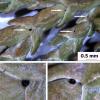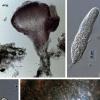
28-11-2025 16:45
Nogueira HéctorNovember 23, 2025 Requejo de Sanabria (León) SPAI

28-11-2025 16:45
Nogueira HéctorNovember 23, 2025 Requejo de Sanabria (León) SPAI

17-09-2025 10:50
Heather MerryleesHi there!I am hoping for any advice on the identif

27-11-2025 15:41
Thomas LæssøeSpores brownish, typically 4-celled; 26.8 x 2.4;

27-11-2025 12:01
Thomas Læssøehttps://svampe.databasen.org/observations/10496727

27-11-2025 11:46
Thomas Læssøehttps://svampe.databasen.org/observations/10493918

27-11-2025 11:31
Thomas LæssøeCollectors notes: Immersed ascomata, erumpent thro

23-09-2025 13:31
Thomas Læssøehttps://svampe.databasen.org/observations/10534623

25-11-2025 14:24
Thomas Læssøehttps://svampe.databasen.org/observations/10490522

26-11-2025 18:13
The entire run of Mycotaxon is now available throu
This a tiny ascomycete developing just between green leaves of Chamaecyparis spp., which grew in a garden in eastern Spain. Its lifestyle seems to be saprotrophic so no harm symptoms have been observed where it grows. Abundant, but only on specimen per leaf flap.
The black-reddish ascomata are stipitate to pseudostipitate, with an overall slightly clavate shape, often bright, with a basal, hialine bundle of "rhizoids", and diameter ranging from 195 to 340 µm, and the height between 250-430 µm. I believe they are true apothecia, with an irregular disc shape, concave when young and slightly convex in mature individuals; in the later, the surface can be somewhat covered by dark pruina.
Exciple thin, 17-19 µm thick, deep brown to black with a reddish tinge; external layer gelatinized, made up of parallel and radially arranged, septate hyphae, 6-7 µm of diameter. Inner tissue of the stipe arranged as textura intricata.
Hymenium up to 150 µm thick. Hamathecium made up of hyaline, strongly branched-anastomosed ¿pseudoparaphyses?, with abundant granular content, 2-4'5 µm of diameter. They become more compact and gelatinized towards the epithecium and exciple. Asci deeply embedded into the hamathecium, first ellipsoidal and full of VBs, then becoming more fusiform when spores are mature, 8-spored, 75-85 x 16-21 µm. No reaction to I detected.
Spores two-celled, smooth, hyaline, 23-27'3 x 8-9 µm with one cell rather becoming more elongated and narrow.
Any suggestion will be welcomed!!
Regards,
Isaac

look at this one: http://www.landesmuseum.at/pdf_frei_remote/Sydowia_13_0064-0066.pdf
Does it match with Pseudodiscus?
Regards
Martin
Thanks for your suggestion!! It really seems to match to this species. Yesterday I could download the paper and make a fast reading, but I didn't save it; today I can't download it so I am not still able to confirm its identity. Anyway, I think this is a very interesting fungus with a peculiar ecology. Do you know if there are more recent papers where this species is referenced? Or has any collaborator of ascofrance ever found this species?
Thanks in advance!
Regards,
Isaac

I am not aware of any more recent paper on Pseudodiscus. If you can prove the identity, your documentation is possibly the first after Arx&Müller.
Regards
Martin

